“Arre, trust me, I am not at the Yamuna right now, we will not be catching any fish today,” Mahendar Haldar tells a vyapari, or fish buyer, on the phone. “Should I make you listen to the sound of the cooler to prove that I am at home?” he laughs.
Mahender, a fisher, and his six other colleagues are sitting in his house in North Delhi’s Bangali Colony, just a few minutes’ ride away from the Yamuna river. On a good day, they would all be stationed on the riverbanks from 7am to 6pm catching fish. But, today is not one of those days. “Abhi paani chal raha hai [the Yamuna is flowing heavily],” fisher Vishnu Haldar says, as he continues mending a fishing net to catch bigger fish, a bounty of the Yamuna’s monsoon waters.
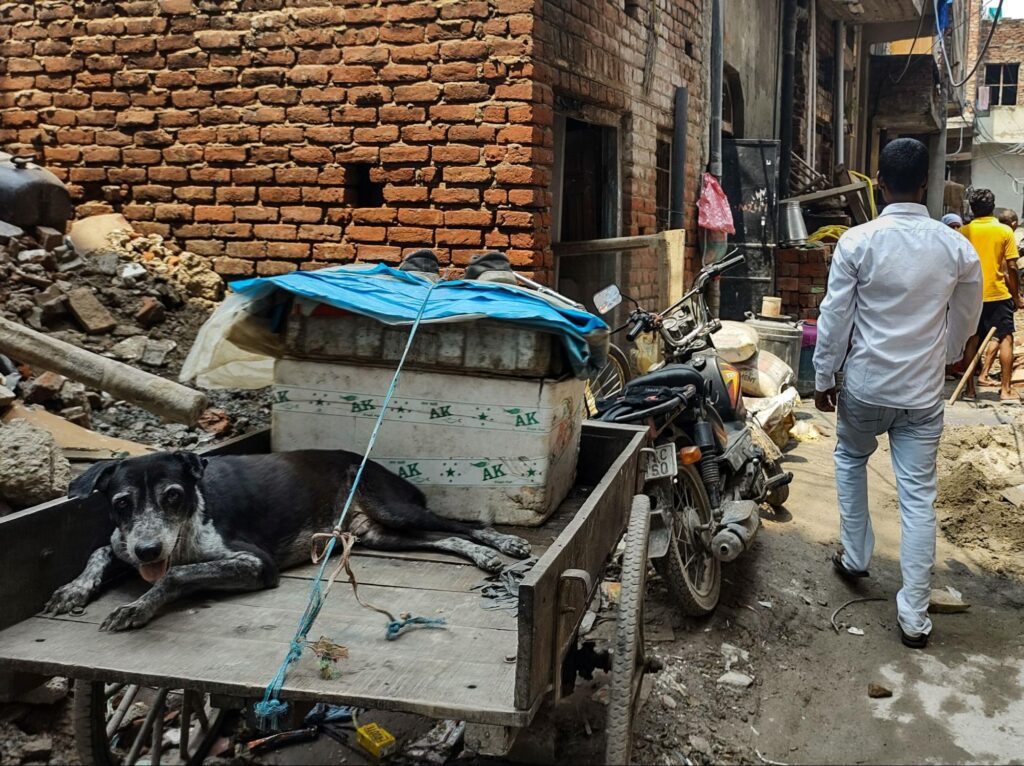
The Yamuna’s deep waters flow silently, only interspersed by the lapping sounds of the river, and the chatter of egrets. Vishnu is right, the flow is indeed high—the Haryana government released Delhi’s legitimate share of 16,000 cusecs of water into the river on the same day. “For the last two years, this river bed has been completely dry. People used to play cricket here,” recalls Mahendar, pointing towards the gushing river.
The fisherfolk in this stretch of the river Yamuna find themselves stuck in a decades long battle between the Delhi and Haryana governments over releasing a fair share of the river’s water across borders. If the Haryana government releases too much or too little water upstream, fishing gets compromised in this stretch near North Delhi’s Wazirabad.
But the impact this has on North Delhi’s fishing economy is barely spoken of amidst the high octane political discussions over water sharing between the Haryana and Delhi state governments. In fact, water sharing isn’t the only government matter wherein Delhi’s 2,500 to 3,000 licensed fishers go unseen.
Delhi’s Master Plan 2041, a document released every 20 years by the Delhi Development Authority (DDA) envisioning the capital’s future land use does not mention the city’s fishers at all. The 9,700 hectares of the Yamuna floodplains—parts of where fishing activities are performed—are mentioned generously in the Plan. But, the Plan’s proposed vision of grass belts, greenways for cycling and walking, and riverfront parks for recreation, make no space for the people who have used the Yamuna’s resources to sustain their livelihoods for decades—like those employed in agriculture and fisheries.
A River that Provides More than Aesthetic Value
“Dekhiye, ye paani ka kaam hai, [Our livelihood depends on what the water provides],” says Mahendar’s brother Krishna, sharpening a knife-like object that will help him cut the rope of the fishing nets. “Some days we go home after selling ₹5,000 worth of catch to a vyapari, sometimes we go home empty handed.” Mahendar and Krishna are thekedaars, or contractors, in North Delhi’s fishing business, where 26 other men work under them. Mostly second generation migrants from West Bengal, many here come from generations of fishers, having learnt the trade from their fathers. This fish—mostly Chinese Rohu and Kavai—is sold locally in North Delhi, just outside their colony, where the demand for fish seems to be high. All their catch is sold on the same day.
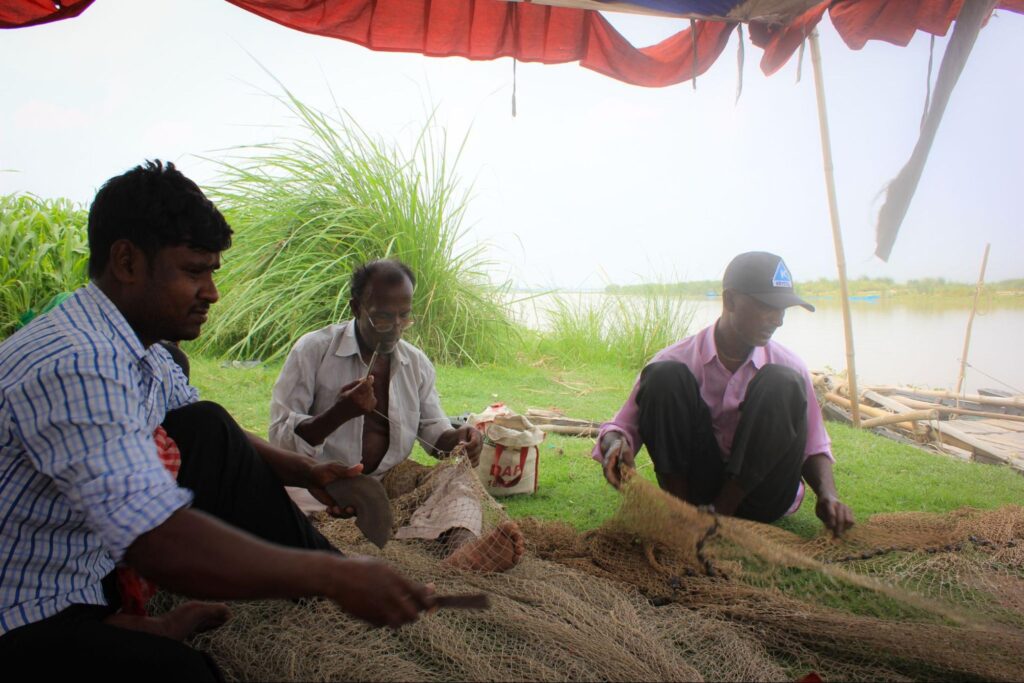
In this part of Delhi, fishing remains an activity dominated by men, where only very few women can be spotted on the Yamuna’s banks with a line and pole to catch a fish or two for their family’s consumption.
While the Yamuna river makes ends meet for half of the fisher’s year, some of the younger men resort to other economic activities for the remaining six months. Driving e-rickshaws and daily labour are a few options for them, while older fishers take this time out to rest.
But, up until 2015, fishers of Bangali Colony had an additional area to fish from just adjacent to Mahendar’s favoured fishing spot between Bangali Colony and Wazirabad—a large pond. “We would lease the channel from the government for a year for an annual charge between ₹80,000 to ₹1 lakh,” Mahendra informs. “The money we earned from the catch would run our homes, and what we earned at the main river bank was over and above that.”
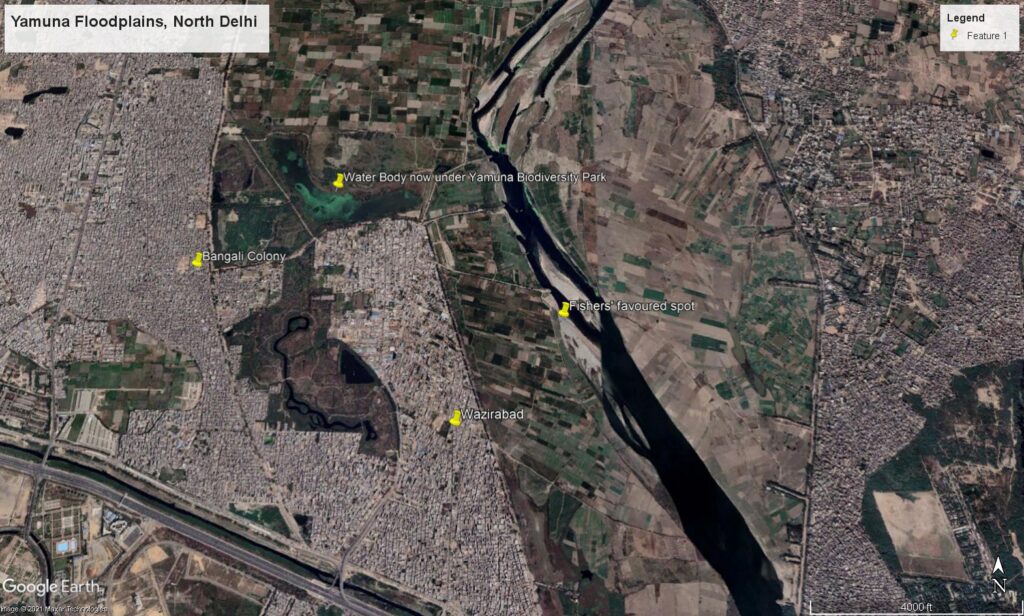
But today, this stream is inaccessible to the fishers. It is now a part of the Yamuna Biodiversity Park developed by the DDA in 2015. This Park, complete with a sacred grove, a butterfly park, herbal garden, and wetlands, has become a choice spot for recreation and education for many in the city. But, it has excluded the fishers who depended on fragments of the same area.
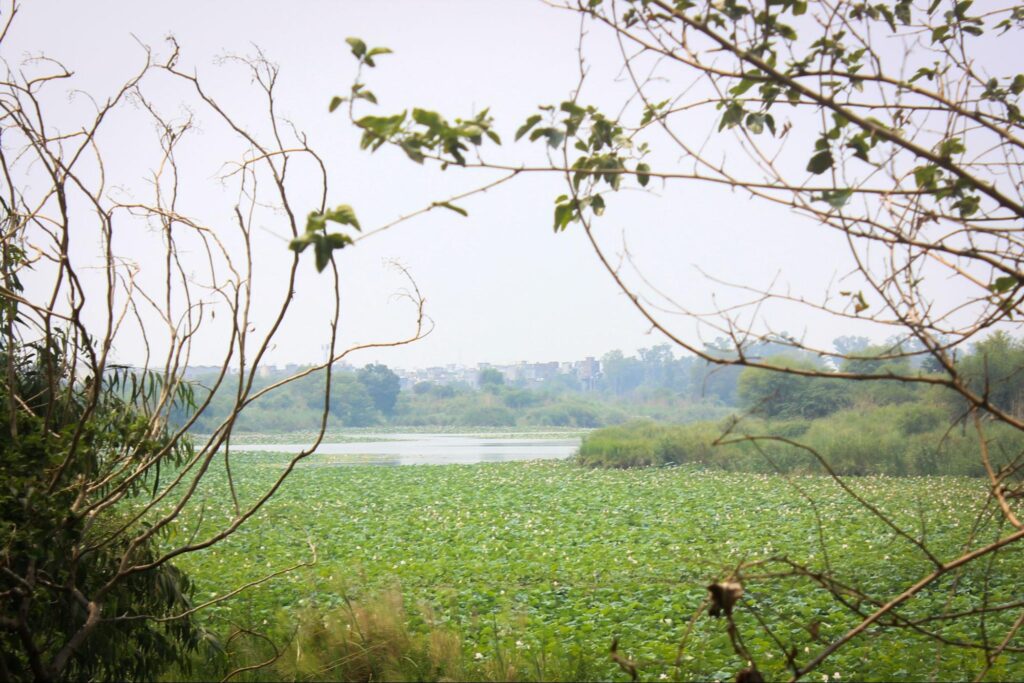
“Residents from near-by areas came to jog along the stretch of the main river bank where we fish everyday,” says Krishna. “Those areas are anyway being used for recreation along with fishing, so what was the need of this park? Bilkul hi befaltu hai wo [the park seems to have no purpose].” That this singular purpose of recreation would continue to define the use of the area in the years to come disappoints the fishers, and their exclusion from the Master Plan worries them.
“Are you sure we are not mentioned anywhere in a 400 page document?” they ask.
“In this core idea or vision of what Delhi should look like [according to the DDA], there is no presence of agriculture or fishing,” shares Rajendra Ravi associated with the National Alliance for People’s Movements (NAPM), who has also worked with the fishing communities of Delhi. What the city’s administration chooses to see—and not see—also impacts the governance around fisheries in Delhi.
Who is Governing Fisheries in Delhi?
“Fisheries comes under states’ Agriculture Departments. But in Delhi, there is no such department, or Minister,” shares Ravi. “What we do have is a Department of Development and a Minister responsible for it, under which fisheries, agriculture, rural development, and animal husbandry are listed.”
Illustrating how administrative territories stay murky, Ravi adds, “when the government occasionally provides monetary support to farmers in Delhi, I have found that it is disbursed from the Social Welfare Department, not from any of the funds of this Development Department.”
Delhi’s expenditure budget for fisheries throws up disappointing results. For 2020-21, a budget of ₹ 2.02 crores was estimated for fishing expenditure, which was revised to 56% lesser the same year. For this year, the budget allocated has further reduced by 31%.
“We got to know from the news that during the lockdown, a scheme for fishers in the country was announced,” says Vishnu, momentarily stepping out to light a beedi. “But none of us here have benefitted from it.” Vishnu is referring to the Pradhan Mantri Matsya Sampada Yojana (PMMSY) released under the Atmanirbhar Bharat COVID-19 Relief Package in September 2020. Amongst other objectives, financial assistance allocated to fishers under the scheme was promised to support fishers’ families during April and June, months when fishing is banned for fish to spawn. Gopal Rai, the sitting Minister for the Department of Development under the Delhi government, was out of station and unavailable to comment on the disbursement of funds.

“Pre-pandemic too, we did not receive subsidies or any other financial support from the Delhi government,” says Mahender as he waves to greet a group of Bihari men across the Yamuna, the only community other than Bengalis who fish in this stretch.
His colleague Bishwa agrees. “In villages in West Bengal and Andhra Pradesh, I know fisher communities get monetary support for equipment like fishing nets, and are even introduced to skills like rearing fish in ponds and cage culture.” Such financial support can be beneficial for fishers in areas where high investment costs are incurred. A new fishing net costs about ₹550/kg, adding upto ₹3 lakh for the amount of net they need to fish the river’s waters. Other operational costs also pile up—such as repairing their fishing boats, or buying new oars.
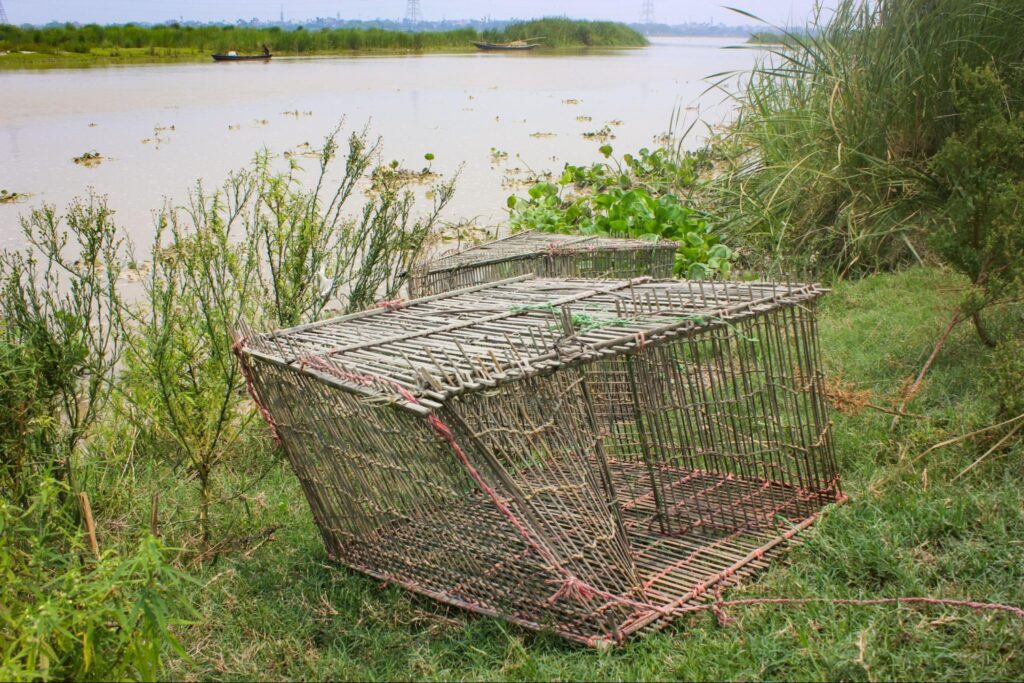
With the lack of government funding threatening the community’s prospects, Mahendar and other fishers here decided to take matters in their own hands. A few years ago, they attempted to form a registered cooperative of fishers in Delhi. “We thought this would give us an identity, that we could make pointed demands to the government as a cooperative,” Mahendar says.
But when the team went to the Department of Registrar Co-operative Society in Delhi, their request was denied. “Apparently, the officers there were shocked and asked where fishing could be done in Delhi, despite the fishers telling them of their decades long livelihood,” NAPM’s Ravi adds. “Currently, the very limited visibility that fishers have is only because of the lower level bureaucracy with whom the fishers deal with when they procure their fishing licenses. Only these officers interact with the fishers on a frequent basis. Higher up in the bureaucratic ladder, not many know of fisherfolk’s existence.”

Fishers close to Wazirabad in Delhi continue asserting their identity, but the rapidly developing city does not wait for them. On the contrary, the unwanted byproducts of development flow into their main source of livelihood—the Yamuna.
Polluted Waters and a Diminishing Livelihood
“At least twice a year, the waters in this stretch of Yamuna become completely dark,” says Bishwa, describing the toxicity of Yamuna. Mahendar adds, “in those times, if you wade through the water, your feet and thighs start itching.”
For these fishers who often have to wade into the river’s waters to spread out their nets, the itching is unavoidable. The group suspects that textile and leather mills in Panipat, about 90 kilometres upstream, are discharging their effluents into the river. Shoals of dead fish end up floating on the river when its waters turn dark.
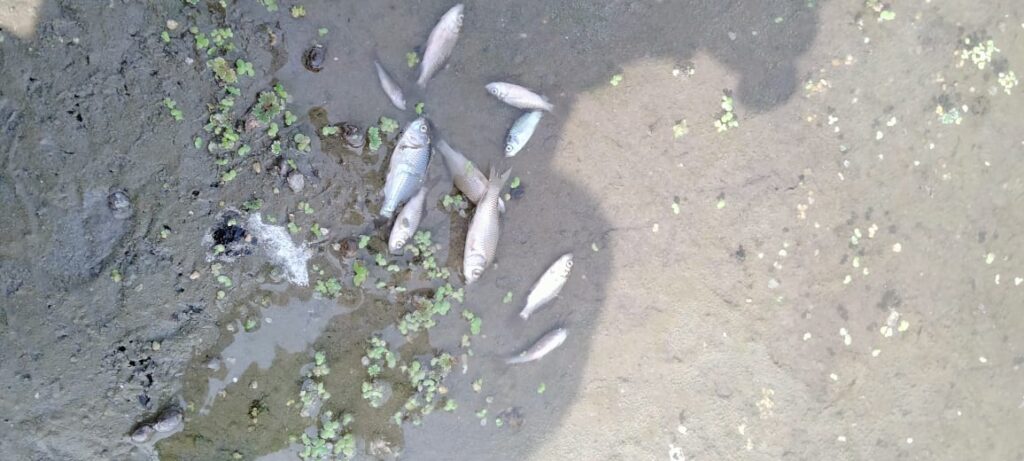
“At the end of the day, the ecological services of agriculture and fisheries are connected, which is why fisheries need to be seen as an allied activity of agriculture,” explains Ravi. “Agriculture productivity will enhance with clean water, which is also needed for a healthy fish population. Having a thriving fish population in turn maintains the quality of water.”
The fishers here ensure that the fish population remains healthy. “Even when we accidentally catch the younger, smaller fish, we let them all go. We know that later, upon growing, they will be the ones that will help us earn our revenue,” Mahendar says. “Which is why, when juveniles end up dying due to the polluted waters, it really makes us frustrated.”
Highlighting a “people river connect”, earlier this month, Mei Bhi Dilli, a citizen’s collective to make planning in Delhi more inclusive and representative, discussed demands that it had presented to DDA specifically for a floodplain zone, or “Zone O”. They asked the Master Plan to identify and map farming settlements in Zone O and integrate existing farming and fishing practices into the Plan after consulting with the communities here.
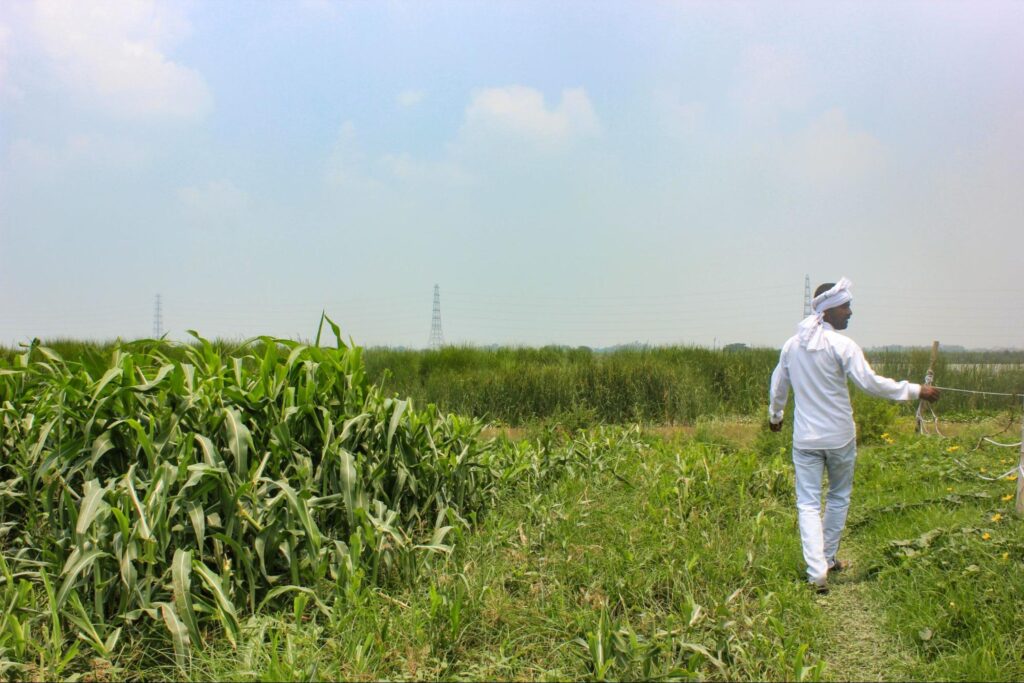
“We want to be identified and want the government to recognise us as the beneficiaries of various fisheries schemes available,” Krishna says. “There are so many ponds in Delhi, why can’t some of these be developed for fish farming?” Krishna’s colleague Vishnu chimes in.
A pair of white herons fly low on to the river bank. “You come in the winter, and you’ll see so many more species of birds!” says Krishna, as he begins listing down species of bird names in Hindi, a lesser-known set of ecological knowledge that might not get transferred to the next generation. None of the fishers here want their children to fish for a living.
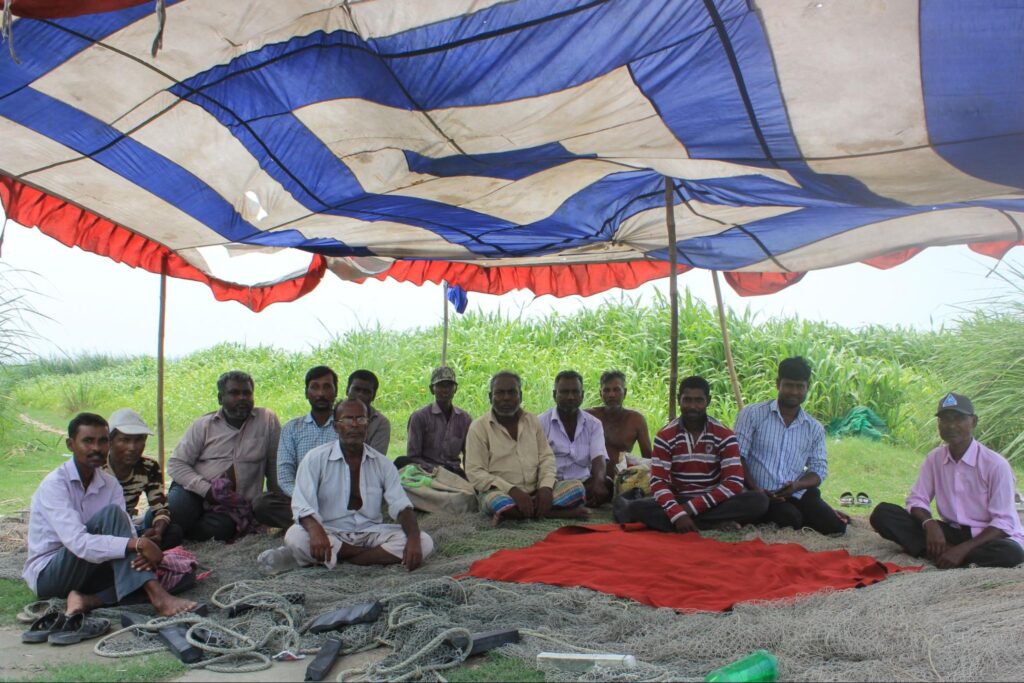
Vishnu, Mahender and their colleagues might be the last generation of fishers in Delhi. This early demise seems to be accentuated by a growing city that has barely recognised them through the years, and by skipping them in the 2041 Master Plan, continues to neglect them in the capital’s future.
Acknowledgment: The author thanks the People’s Resource Centre, who have been documenting fishers in North Delhi, for sharing valuable information to help build this piece.
Suggestions and feedback about Delhi master Plan 2041 are open until 23 August, 2021. To file your comments, head over to the Delhi Development Authority’s website.
Featured image: a fishing boat docked on the Yamuna in Delhi; by Vaishnavi Rathore.







[…] [Originally published in The Bastion (Link to the original article)] […]